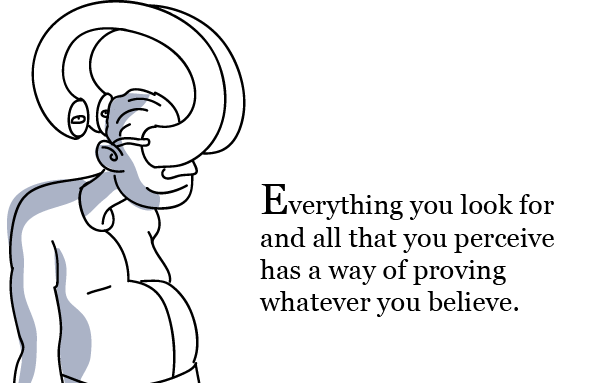Can I have your undivided attention, please? For a captivating journey into a mesmerizing aspect of our psychology that influences nearly everything in our lives, yet you may not even be aware of it.
Say hello to Attention Bias, the invisible puppeteer skillfully pulling the strings behind your choices, nudging you to concentrate on certain things while rendering other options or opportunities practically invisible.
Let me ask you a question. Have you ever found yourself catastrophizing? You know, when you experience moments where you just can’t help but imagine the worst possible outcome?
For example, imagine you’re scrolling through your social media feed, and you notice a few posts about friends going on fabulous vacations, hitting life milestones, or achieving significant career success. You start to feel like everyone is living a more exciting life than you. This is attention bias at play. You’re focusing on selective examples that make you feel inadequate, forgetting that social media rarely shows the struggles, hard work, or mundane moments that everyone experiences.
Or how about this?
You’re at work, and you make a minor mistake on a project. For the rest of the day, you can’t help but fixate on this one error, ignoring the dozens of things you’ve done exceptionally well. You start to think that your performance is slipping and that your job might be at risk. Attention bias makes you zero in on the negative, overshadowing all the positives that offer a more balanced, truthful narrative.
You may be wondering, “Isn’t the whole purpose of attention to focus on certain things?” Well, yes, it is but here lies the conundrum: What are you focusing on?
While attention bias originated as a survival mechanism—helping us prioritize immediate safety over lesser concerns—its role has evolved. In today’s world, that same bias can often serve as a roadblock rather than a lifesaver.

Credit: JG
Extensive research (yes, we are talking about legitimate studies here!) reveals that fixating disproportionately on specific possibilities while neglecting others can compromise our decision-making abilities and even distort our memories. Have you ever emerged from a heated argument fervently convinced that you were the epitome of reason, only to later admit, perhaps begrudgingly, that your partner had some valid points too? Just imagine the transformative difference it would make if we approached those moments with complete awareness and heartfelt compassion from the very beginning!
So, let’s unravel this intricate web. Together, we will debunk the myths and navigate the treacherous minefield of attention bias, enabling you to embody your most empowered and authentic self.
Are you ready? Let’s go!
Introducing the FACTT Method:
Your 5-Step Guide to Navigating Attention Bias
We all experience moments where our thoughts and emotions cloud our judgment. These situations can lead us down paths of stress, regret, and poor decision-making. That’s why I’ve created the FACTT Method—a structured, 5-step exercise designed to help you face and navigate attention bias in any situation. This method equips you with the tools to scrutinize your thoughts, challenge your assumptions, and make well-informed decisions that align with reality, not just perception.
And here’s the transformative part: Initially, you might use the FACTT Method to dissect specific circumstances in a reflective manner. But as you practice it consistently, something magical happens: it begins to turn into a natural, almost automatic, way of thinking. This ingrained habit will empower you to cut through the fog of emotional complexity in real-time, enhancing not just your decision-making abilities but your overall well-being. It’s a game-changer for your relationships, your career success, and even your sense of inner peace.
How to Use This Exercise:
- Find a Quiet Space: This exercise requires introspection, so choose a location where you can focus.
- Be Honest: Self-reflection only works when you’re willing to be truthful with yourself.
- Take Your Time: This isn’t a race. Give yourself the space to think deeply at each step.
- Use a Journal: Writing down your thoughts can make them easier to analyze. If you can, jot down your responses to each prompt. If you don’t have a journal, you can purchase my Mindful Not Mind Full journal here.
- Revisit Regularly: The more you practice this exercise, the better you’ll get at identifying and overcoming your attention biases. Remember, the goal is to rewire your thinking habits so that you can begin to do this in real time!
Ready? Let’s delve into the FACTT Method.
Step 1: Face Your Thoughts (F)
Objective: Examine your thoughts to prevent them from leading you astray emotionally.
Journaling Prompts:
Situation: Describe what’s happening. Be as detailed as possible.
Thoughts: What’s on your mind? Are you overgeneralizing, catastrophizing, or making assumptions?
Emotions: What are you feeling? Identify your emotions.
Action: Choose one thought or thought distortion for further examination.
Step 2: Assemble Your Evidence (A)
Objective: Construct a ‘case’ around the thought or distortion you’ve chosen.
Journaling Prompts:
Supporting Evidence: What facts, past experiences, or observations support your thought? These could be self-affirmations that might not be entirely accurate.
Assumptions: List underlying beliefs that make you think your thought is true.
Step 3: Challenge the Evidence (C)
Objective: Question your initial perspective.
Journaling Prompts:
Contrary Evidence: Identify facts or experiences that contradict your initial thought.
Step 4: Test Your Assumptions (T)
Objective: Separate fact from fiction.
Journaling Prompts:
Verifiable Truth: Scrutinize your collected evidence. What can you confirm as undeniably true?
What can you define as false in this situation?
Step 5: Take Action (T)
Objective: Make a well-informed decision based on your analysis.
Action Steps:
If True: Equip yourself with coping skills that address the reality of the situation, not just your perceptions.
If False: Use counter-thoughts to challenge and shift your initial thinking to align with the verifiable truth.
Now, to make it a little easier for you, let me give you an example that many of us can relate to.
Example: You’re stuck in traffic and running late for a crucial meeting.
Step 1: Face Your Thoughts (F)
What’s the Situation?
You’re stuck in a traffic jam and you have an important meeting to attend.
Thoughts and Thought Distortions:
“I’m going to be so late! They’ll never consider me for that promotion now.”
Emotions:
Anxiety, frustration, panic.
Action:
Choose a thought distortion: “They’ll never consider me for that promotion now.”
Step 2: Assemble Your Evidence (A)
Supporting Evidence:
You remember other times in your life when being late impacted how others saw you.
Assumptions:
Punctuality is the only criterion considered for a promotion.
Step 3: Challenge the Evidence (C)
Contrary Evidence:
Your consistent performance, leadership skills, and positive feedback from colleagues.
Step 4: Test Your Assumptions (T)
The Verifiable Truth:
You are usually punctual, have shown strong performance, and received positive feedback time and again in your profession.
Step 5: Take Action (T)
Is it True or False?
False. The thought is a distortion.
If it’s false, counter-thoughts are your allies.
Counter-thought: “Being late once won’t eliminate me from a promotion. I’ve been consistent and received positive feedback. I’ll apologize and make up for it.”
By mastering the FACTT Method, you’re not just tweaking a thought process—you’re elevating your entire life experience. This tool isn’t just for those traffic jam moments or work anxieties; it’s a transformative practice that enhances your relationships, clarifies your decision-making, and deepens your self-awareness. The more you apply it, the more you’ll find that you don’t just navigate challenges better—you’ll also recognize opportunities you might have otherwise overlooked.
And here’s the game-changer: As you consistently apply this method, you’ll cultivate a mental agility that empowers you to assess situations in real-time. That means less regret, more alignment with your core values, and a life led by empowered choice rather than emotional impulse.
Ready to take your life to the next level? The FACTT Method is just a taste of the transformative tools and techniques I cover in my “Elevate Your Life” coaching program. If you’re serious about transforming not just your thoughts, but your entire life trajectory, I invite you to join me on a personal journal to Elevate Your Life®!
Click here to apply for a discussion!
So go ahead, be the empowered author of your life story. Because let’s face it: if you’re not writing your own narrative, who is?




